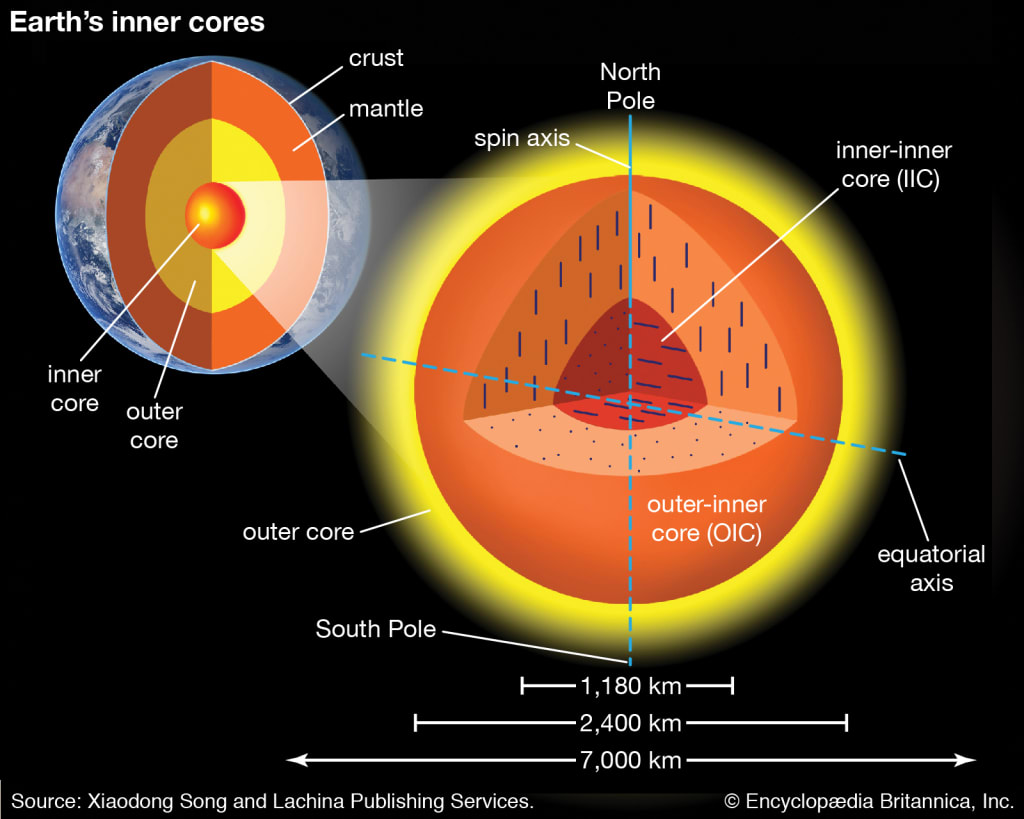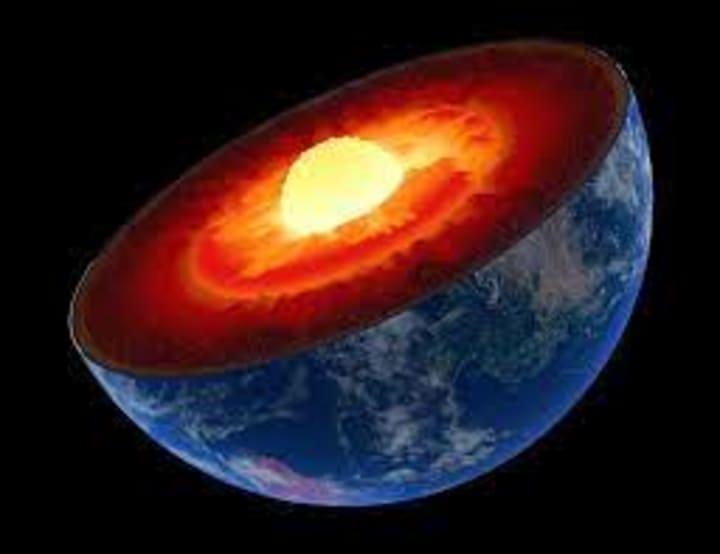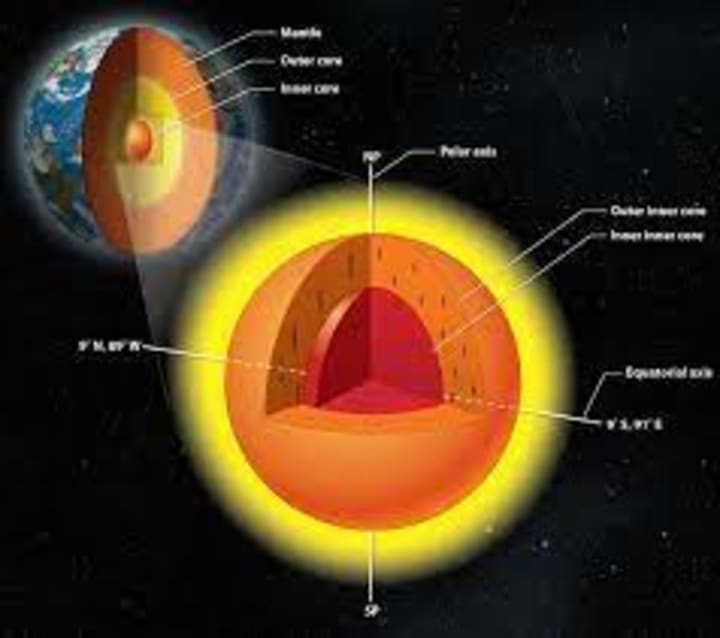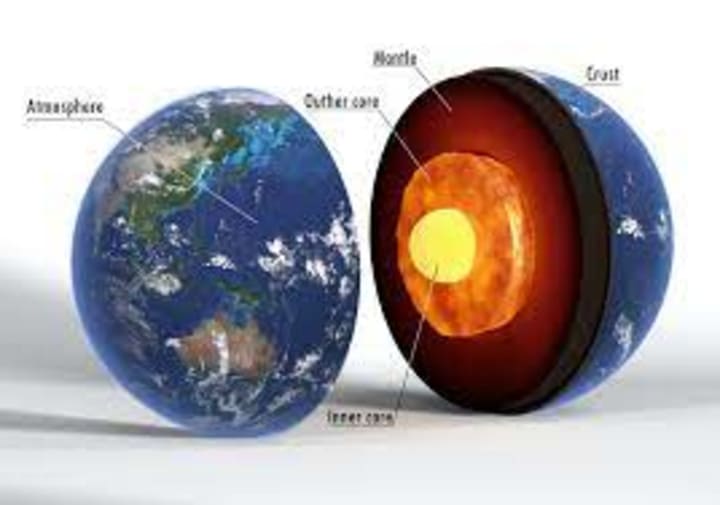Earth's center
Humans live on the surface of the Earth, the crust. Below the crust is the mantle. The core of the Earth sits about 2,900 kilometers (1,802 miles) below the crust.

Earth's center is the exceptionally hot, extremely thick focal point of our planet. The ball-molded center lies underneath the cool, weak outside and the for the most part strong mantle. The center is found around 2,900 kilometers (1,802 miles) underneath Earth's surface, and has a sweep of around 3,485 kilometers (2,165 miles).
Planet Earth is more seasoned than the center. At the point when the Earth shaped with regards to 4.5 billion years prior, it was a uniform bundle of hot stone. Radioactive rot and extra warmth from planetary arrangement (the crash, growth, and pressure of room rocks) made the ball settle the score more smoking. In the end, after around 500 million years, our young planet's temperature warmed to the liquefying point of iron—about 1,538° Celsius (2,800° Fahrenheit). The name of this vital crossroads in Earth's set of experiences is the iron calamity.
The iron calamity permitted more prominent, more fast development of Earth's liquid, rough material. Moderately light material, like silicates, water, and even air, remained nearby the planet's outside. These materials turned into the early mantle and outside. Beads of iron, nickel, and other weighty metals inclined toward the focal point of Earth, turning into the early center. This significant cycle is planetary separation.
Earth's center is the heater of the geothermal slope. The geothermal slope estimates the expansion of warmth and pressing factor in Earth's inside. The geothermal inclination is about 25° Celsius per kilometer of profundity (1° Fahrenheit per 70 feet). The essential supporters of warmth in the center are the rot of radioactive components, extra warmth from planetary arrangement, and warmth delivered as the fluid external center hardens close to its limit with the internal center.

In contrast to the mineral-rich outside and mantle, the center is predominantly made out of metal—explicitly, iron and nickel. The shorthand utilized for the center's iron-nickel composites is just the components' substance images—NiFe.
Components that break down in iron, called siderophiles, are likewise found in the center. Since these components are discovered substantially more seldom on Earth's outside, numerous siderophiles are "valuable metals." Siderophile components incorporate gold, platinum, and cobalt.
One more key component in Earth's center is sulfur—truth be told 90% of the sulfur on Earth is found in the center. The affirmed revelation of such tremendous measures of sulfur clarified a geologic secret: If the center was principally NiFe, for what reason wasn't it heavier? Geoscientists estimated that lighter components, for example, oxygen or silicon may have been available. The bounty of sulfur, another generally light component, clarified the problem.

In spite of the fact that we realize that the center is the most sultry piece of our planet, its exact temperatures are hard to decide. The fluctuating temperatures in the center rely upon pressure, the pivot of the Earth, and the changing organization of center components. As a rule, temperatures range from about 4,400° Celsius (7,952° Fahrenheit) to about 6,000° Celsius (10,800° Fahrenheit).
The center has two layers: the external center, which borders the mantle, and the internal center. The limit isolating these locales is the Bullen intermittence.
External Core

The external center, around 2,200 kilometers (1,367 miles) thick, is for the most part made out of fluid iron and nickel. The NiFe combination of the external center is extremely hot, somewhere in the range of 4,500° and 5,500° Celsius (8,132° and 9,932° Fahrenheit).
The fluid metal of the external center has exceptionally low consistency, which means it is handily disfigured and flexible. It is the site of vicious convection. The agitating metal of the external center makes and supports Earth's attractive field.
The most sweltering piece of the center is really the Bullen brokenness, where temperatures arrive at 6,000° Celsius (10,800° Fahrenheit)— as blistering as the outer layer of the sun.
Inward Core

The inward center is a hot, thick bundle of (generally) iron. It has a range of around 1,220 kilometers (758 miles). Temperature in the inward center is about 5,200° Celsius (9,392° Fahrenheit). The pressing factor is almost 3.6 million climate (atm).
The temperature of the inward center is far over the dissolving point of iron. Nonetheless, in contrast to the external center, the internal center isn't fluid or even liquid. The internal center's extreme pressing factor—the whole rest of the planet and its climate—keeps the iron from softening. The pressing factor and thickness are basically excessively incredible for the iron particles to move into a fluid state. As a result of this surprising situation, a few geophysicists like to decipher the internal center not as a strong, but rather as a plasma acting as a strong.
The fluid external center isolates the internal center from the remainder of the Earth, and therefore, the inward center pivots somewhat better than the remainder of the planet. It pivots toward the east, similar to the surface, yet it's somewhat quicker, making an additional turn about at regular intervals.

Geoscientists imagine that the iron gems in the inward center are in an "hcp" (hexagonal close-pressed) design. The precious stones adjust north-south, alongside Earth's hub of turn and attractive field.
The direction of the precious stone design implies that seismic waves—the most dependable approach to consider the center—travel quicker while going north-south than while going east-west. Seismic waves travel four seconds quicker post to-shaft than through the Equator.
Development In The Inner Core
As the whole Earth gradually cools, the internal center develops by about a millimeter consistently. The inward center develops as pieces of the fluid external center cement or take shape. One more word for this is "freezing," despite the fact that recall that iron's edge of freezing over is more than 1,000° Celsius (1,832° Fahrenheit).
The development of the internal center isn't uniform. It happens in bumps and bundles impacted by movement in the mantle.
Development is more thought around subduction zones—districts where structural plates are slipping from the lithosphere into the mantle, a large number of kilometers over the center. Subducted plates draw heat from the center and cool the encompassing region, causing expanded examples of cementing.
Development is less focused around "superplumes" or LLSVPs. These swelling masses of superheated mantle rock probably impact "problem area" volcanism in the lithosphere, and add to a more fluid external center.
The center won't ever "freeze solid." The crystallization cycle is extremely sluggish, and the steady radioactive rot of Earth's inside eases back it much further. Researchers gauge it would require around 91 billion years for the center to totally harden—however the sun will wear out in a negligible part of that time (around 5 billion years).
Center Hemispheres

Actually like the lithosphere, the inward center has eastern and western sides of the equator. These sides of the equator don't soften equitably, and have particular translucent designs.
The western side of the equator is obviously taking shape more rapidly than the eastern half of the globe. Indeed, the eastern half of the globe of the inward center may really be softening.
Inward Inner Core

Geoscientists as of late found that the inward center itself has a center—the internal center. This odd element varies from the inward center similarly the internal center contrasts from the external center. Researchers believe that an extremist geologic change around 500 million years prior made this inward internal center create.
The gems of the inward internal center arrange east-west rather than north-south. This direction isn't lined up with either Earth's rotational hub or attractive field. Researchers figure the iron gems might even have something else altogether (not hcp), or exist in an alternate stage.
Attraction

The twirling external center makes the Earth's attractive field. Attraction in the external center is multiple times more grounded than it is on a superficial level.
It very well may be not difficult to consider the reason for Earth's attraction the huge bundle of strong iron in the center. Yet, in the inward center, the temperature is high to the point that it adjusts the attraction of iron. When this temperature arrives at this point, called the Curie point, the iotas of a substance can presently don't adjust to an attractive point.
Dynamo Theory
Some geoscientists depict the external center as Earth's "geodynamo." For a planet to have a geodynamo, it should pivot, it should have a liquid medium in its inside, the liquid should can direct power, and it should have an inward energy supply that drives convection in the fluid.
Varieties in pivot, conductivity, and warmth sway the attractive field of a geodynamo. Mars, for example, has an absolutely strong center and a feeble attractive field. Venus has a fluid center, yet pivots also leisurely to stir huge convection flows. It, as well, has a frail attractive field. Jupiter, then again, has a fluid center that is continually twirling because of the planet's fast turn.
Earth is the "Goldilocks" geodynamo. It turns consistently, at an energetic 1,675 kilometers each hour (1,040 miles each hour) at the Equator. Coriolis powers, a curio of Earth's turn, cause twisting convection flows. The fluid iron in the external center is an amazing electrical channel, and makes the electrical flows that drive the attractive field.
Beads of fluid iron that freeze onto the strong inward center give the energy supply that drives convection in the external center. Hardening discharges heat energy. This warmth, thus, makes the excess fluid iron more light. Hotter fluids winding vertical, while cooler solids twisting lower under extraordinary pressing factor: convection.






Comments
There are no comments for this story
Be the first to respond and start the conversation.